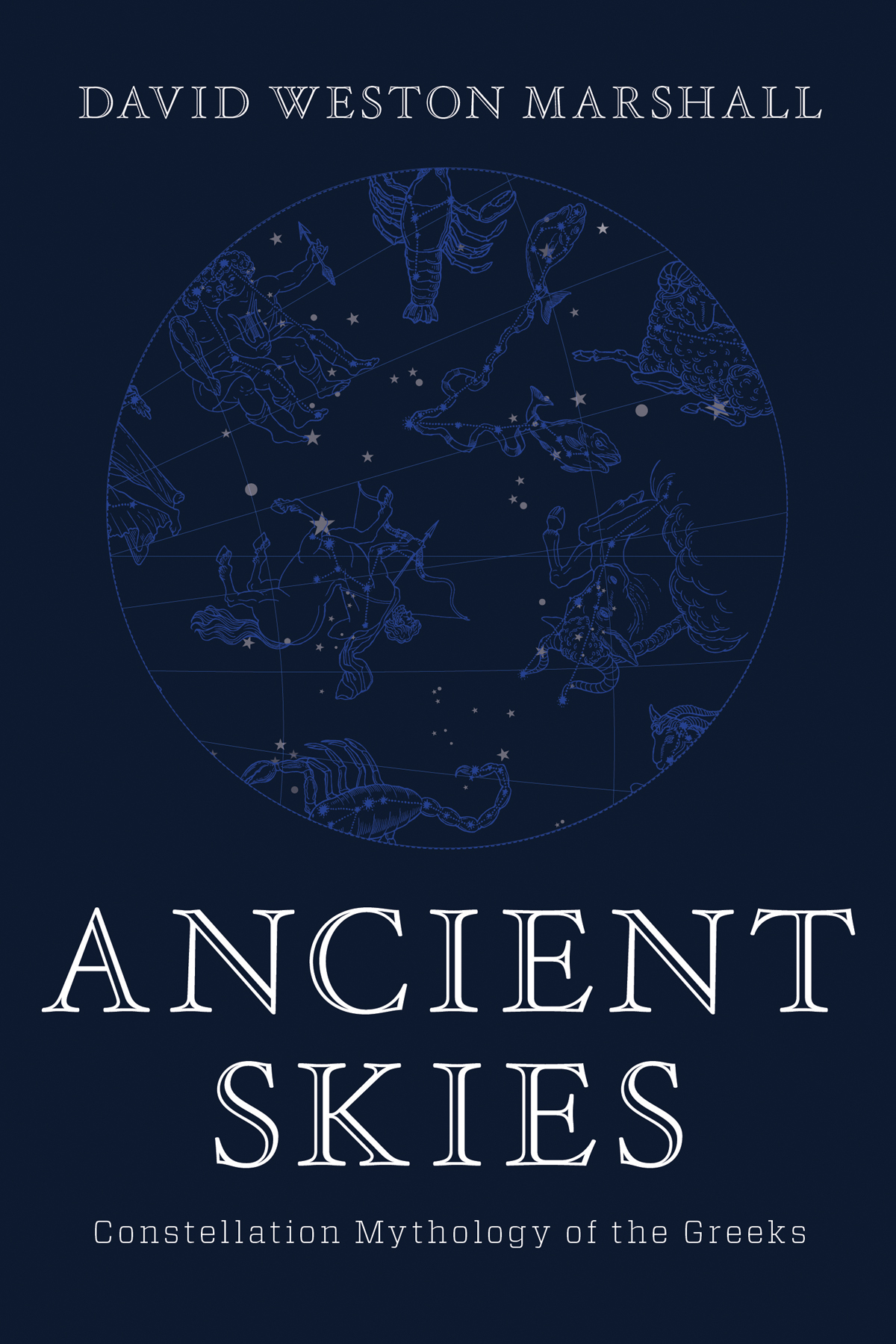David Weston Marshall - Ancient Skies
Here you can read online David Weston Marshall - Ancient Skies full text of the book (entire story) in english for free. Download pdf and epub, get meaning, cover and reviews about this ebook. year: 2018, publisher: Countryman Press, genre: Detective and thriller. Description of the work, (preface) as well as reviews are available. Best literature library LitArk.com created for fans of good reading and offers a wide selection of genres:
Romance novel
Science fiction
Adventure
Detective
Science
History
Home and family
Prose
Art
Politics
Computer
Non-fiction
Religion
Business
Children
Humor
Choose a favorite category and find really read worthwhile books. Enjoy immersion in the world of imagination, feel the emotions of the characters or learn something new for yourself, make an fascinating discovery.

- Book:Ancient Skies
- Author:
- Publisher:Countryman Press
- Genre:
- Year:2018
- Rating:4 / 5
- Favourites:Add to favourites
- Your mark:
- 80
- 1
- 2
- 3
- 4
- 5
Ancient Skies: summary, description and annotation
We offer to read an annotation, description, summary or preface (depends on what the author of the book "Ancient Skies" wrote himself). If you haven't found the necessary information about the book — write in the comments, we will try to find it.
Ancient Skies — read online for free the complete book (whole text) full work
Below is the text of the book, divided by pages. System saving the place of the last page read, allows you to conveniently read the book "Ancient Skies" online for free, without having to search again every time where you left off. Put a bookmark, and you can go to the page where you finished reading at any time.
Font size:
Interval:
Bookmark:

DAVID WESTON MARSHALL

THE COUNTRYMAN PRESS
A division of W. W. Norton & Company
Independent Publishers Since 1923
Copyright 2018 by David Weston Marshall
All rights reserved
For information about permission to reproduce selections from this book, write to Permissions, The Countryman Press, 500 Fifth Avenue, New York, NY 10110
For information about special discounts for bulk purchases, please contact W. W. Norton Special Sales at specialsales@wwnorton.com or 800-233-4830
Book design by Anna Reich
Production manager: Devon Zahn
Cover art Iryna Zinenko / Zizi Market / Creative Market
Jacket design by Anna Reich
The Countryman Press
www.countrymanpress.com
ISBN 978-1-68268-212-8 (e-book)
A division of W. W. Norton & Company, Inc.
500 Fifth Avenue, New York, NY 10110
www.wwnorton.com
978-1-68268-211-1

for vicki
Auriga, Capricornus, Pisces, Piscis Austrinus, Delphinus, Aquila, Aquarius, Ara
Virgo, Sagittarius, Corona Australis, Centaurus, Lupus, Triangulum, Corvus, Crater
Ursa Major, Bootes, Ursa Minor, Cygnus, Taurus, Corona Borealis
Orion, Scorpius, Libra, Lepus, Canis Major, Canis Minor, Eridanus
Perseus, Andromeda, Cetus, Cepheus, Cassiopeia, Pegasus, Equuleus, Draco, Hercules, Hydra, Leo, Cancer, Sagitta
Aries, Argo Navis, Lyra, Ophiuchus, Serpens, Gemini
S TEP OUTSIDE, AWAY FROM THE LIGHT, into the dark and mysterious night. Stand beneath the boundless skies with eyes toward the shining stars. Move your mind beyond the Earthbeyond the here-and-now.
Suddenly, you see a universe of immeasurable size and immense age. You perceive our planet as a cosmic speck orbiting an ordinary star. This star, called the Sun, is only one of billions of stars in our galaxy. And our galaxy is only one of billions of galaxies in the universe.
In the vastness of space, you see some stars so far away that their rays have raced at the speed of light for two million years to reach you. These rays began their journey toward Earth at the time of the birth of humankind; and to glimpse them now is to peer that far into the past. They have traveled farther than the mind can fathom. Yet they, and all the stars that human eyes can see in the sky, occupy only a tiny corner of the cosmos.
As you gaze upon the grandeur, you share in a ritual repeated since the dawn of time. Our ancestors of ages past stood and pondered the same shimmering stars with awe and wonder. One, who lived two thousand years ago, spoke for people of all times when he said that the heavenly light draws the gaze of mortals upwards, as they marvel at the strange glow through nights darkness, and search, with mind of man, the cause of the divine.
The ancient Greeks stood foremost among those who searched the stars and contemplated the cosmos. Most of them believed that, long ago, the gods created groups of stars, called constellations, to portray themselves in heaven. They thought the gods assigned other stars to depict the deeds of heroes who had faithfully fought on behalf of fellow mortals. Still other stars illustrated tales of divine protection for the humble, or punishment for the haughty. The Greeks concluded that the constellations, as a whole, offered a god-given gift of moral inspirationan ethical guide for humans to follow.
Some Greeks, like the poet Aratus (315240 BC), declared that humans, not gods, had contrived the constellations. He explained that the men-that-are-no-more noted and marked how to group [the stars] in figures and call all by a single name. For it had passed [their] skill to know each single star, or name them one by one.
These words of Aratus provide a profound tribute to our unknown ancestors, who made the earliest efforts to study and understand the heavens. They dared to venture an explanation of the universe, and imparted priceless knowledge and lore. But, sadly, their names have disappeared forever from our collective memory.
The ancient Greeks built upon these timeless ponderings. By the eighth century BC, they had conceived a basic theory of the form of the cosmos. This was recorded by Homer in the Iliadthe earliest western writing. In the Iliad, the god Hephaestus hammered and forged a shield for the warrior Achilles: On it he fashioned the earth, on it the heavens, on it the sea, and the unwearied sun, and the moon at the full, and on it all the constellations with which heaven is crowned, the Pleiades and the Hyades and mighty Orion, and the Bear... that circles ever in its place, and watches Orion, and alone has no part in the baths of the Ocean.
In this early age, the Greeks already seemed to conceive of an Earth with surface curvature, if not a complete sphere. They knew the phases of the moon, and the names of certain constellations and asterisms. They noted that one constellation, called the Bear, remained ever bright in the night skynever dipping below the horizon into the sparkling sea. They marked the celestial North Pole with the Bears eternal rotation. They perceived that other constellations, as well as the planets, the sun, and the moon, all rose and set beyond Oceanusthat vast body of water thought to encircle the world.
Aratus later described how the stars and constellations hasten from dawn to night throughout all time. Aratus and other ancient observers found comfort in the predictable, steadfast nature of the stars. Unlike so many uncertainties that made life on Earth precarious, they could count on the stars to always be where they were supposed to be and behave the way they were supposed to behave.
But among these thousands of reassuring beacons were several stars that seemed to follow no rules. Aratus noted, Of quite a different class are those five other orbs that intermingle with them and wheel wandering on every side of the twelve figures of the Zodiac, pursuing a shifty course.
Of these wanderers, the morning star named Phosphoros shone forth as the brightest light to bid the night goodbye. Homer described how the day begins when this star of morning goes out to herald light over the face of the earththe star after which follows saffron-robed Dawn.
Hesperos, the evening star, rivaled the beauty of Phosphoros. According to Homer, the star of evening was set in heaven as the fairest of all. In fact, the two stars appeared in essence the same, and seemed to take turns lighting the night sky. At certain times of the year, Phosphoros adorned the morning. At other times, Hesperos graced the evening. But the two never revealed themselves on the same nights.
The explanation for this strange behavior had to await the insight of Pythagoras (c. 572490 BC). The famed astronomer and mathematician discovered that the two were actually one heavenly body that sometimes shone in the morning and other times in the evening. The Greeks renamed the resplendent wandering star for Aphroditethe goddess of love and beauty.
Later, the Romans called the planet Venusthe second brightest celestial light in the night sky, after the moon. On a clear and moonless night, her glow is capable of casting shadows on Earth. Little wonder that she so amazed ancient observers!
Font size:
Interval:
Bookmark:
Similar books «Ancient Skies»
Look at similar books to Ancient Skies. We have selected literature similar in name and meaning in the hope of providing readers with more options to find new, interesting, not yet read works.
Discussion, reviews of the book Ancient Skies and just readers' own opinions. Leave your comments, write what you think about the work, its meaning or the main characters. Specify what exactly you liked and what you didn't like, and why you think so.







